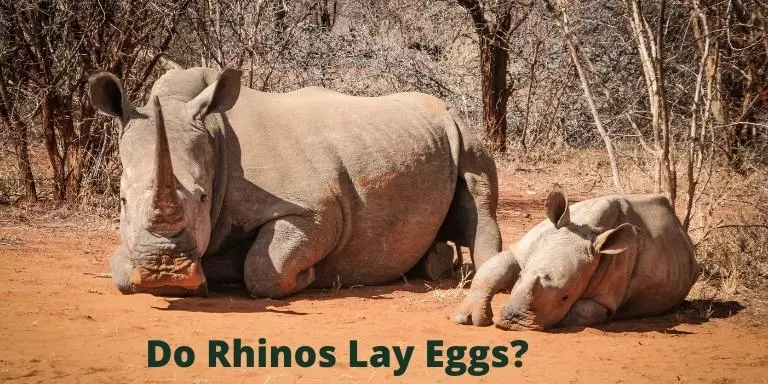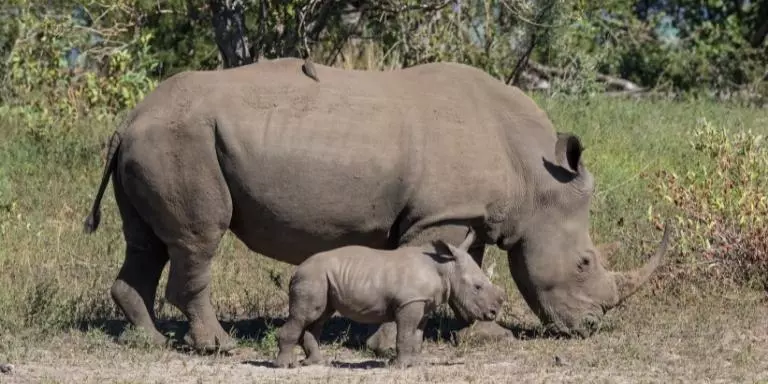Rhinoceros reproduction is a very steady process. The females have relatively longer gestation than other species. They also take more time to mature than many other mammals too. But do rhinos lay eggs?
Female rhinoceros carry ovum in their ovaries but do not hatch. They breed their babies as any other mammal would. However, it is a common misconception to guess that the ancestors of the species were dinosaurs and could lay eggs. The idea arises from the fact that they have a noticeable huge horn on the nose

Do Rhinos lay eggs?
Rhinoceroses do not lay eggs. Their physical structure prevents them from doing so. Their ancestors also bred their babies. The horned animal did not evolve to lay spawns just like other ungulates such as horses and hippos.
It takes about 2 to 4 years for a rhinoceros to become an adult. The time period can vary with species and gender.
Males generally take 2 years to leave their mothers’ companions and females need about 4 years. After that, they leave to mate or find their land.
Female Rhinos have a longer gestation of 15 to 16 months. After that, they breed a single calf.
Besides, if the giants even could produce gametes, they would’ve probably crushed those during incubation. Moreover, the baby would be more vulnerable. With their immense weight, they couldn’t make a suitable nest either.
How do Rhinos reproduce

It is vital for people to learn about the reproduction and life cycle of rhinoceroses. By doing so one can understand their life period and help the species from going extinct.
Females give birth to a single calf but can sometimes have twins. But the reproduction rate is seen to decrease in captivity for unknown reasons.
Females would mate after every 2.5 to 3 years. The newborn has no horn and is full of thick hair. It depends entirely on its mother for both food and protection.
During nurturing the child the mother would not mate or have new babies. For this, she needs at least 4 years or sometimes even longer. As a result, many babies get killed at an early age by angry young bulls.
Rhino ancestry and myths about laying eggs
The ancient rhinoceros family was once the largest living creature on the planet. They ruled the grasslands for millions of years.
The closest living relative of the rhinos is Tapirs at this moment. Horses and Zebras are also closer to them. The animals are called “odd-toed ungulates” altogether.
People, however, tend to think of the giant ungulate as hatching animals. This thought has risen from the armored beast having a giant nasal horn. But their anatomy says otherwise. Their bodies are not designed to be laying eggs. The mammals like any other mammal breed their babies and nurture them.
It is also a misconception to think the horned mammal is a kind of dinosaur. It is also not true. Because both the creatures are not alike. One is a mammal and the other is a reptile.

What animals can lay eggs?
However, many other creatures in the animal kingdom lay eggs for reproduction. Such as birds. Birds make their nests on trees or someplace similar. They are warm-blooded creatures and hatch their newborns by incubating the egg.
After that, the baby is entirely dependent on its parents. The nest provides for the protection and warmth that a newborn needs.
Most fish also produce gametes. They are cold-blooded creatures and swim in the waters. But some fish give birth to babies like mammals. Some can even breathe air.
Reptiles are worth mentioning in this list. The cold-blooded creatures walk on their bellies and produce gametes.
Besides these amphibians and insects are also on the list.
Conclusion
Rhinoceroses do not lay eggs. They are mammals and naturally bear their babies. But many myths have taken place over the time period because of them carrying a massive nasal horn.
You might also be interested in:
